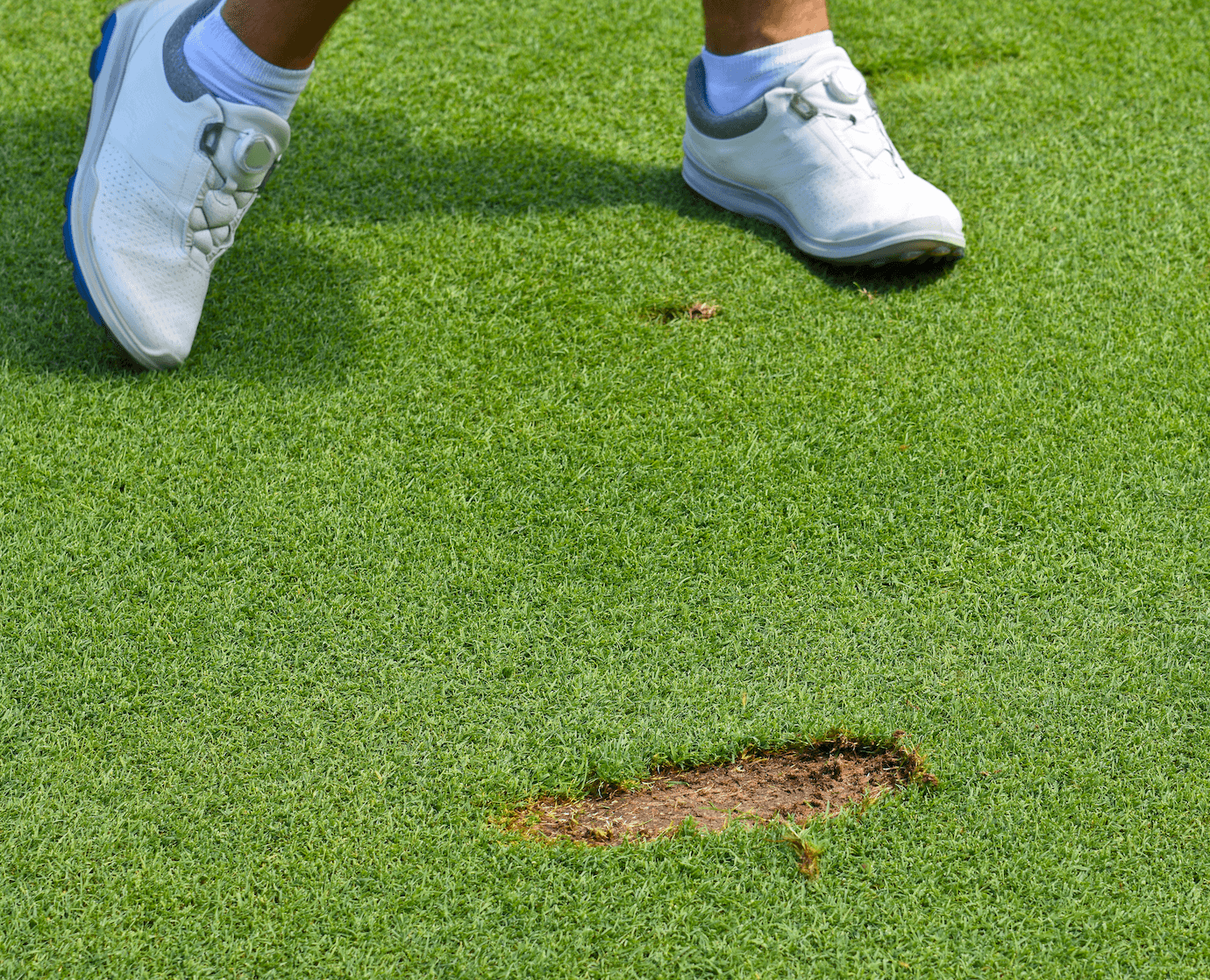The MyGolfSpy staff thinks I’m crazy.
That might be true, but I’m nonetheless willing to die on this hill: golfers shouldn’t get free relief from fairway divots.
Before I make my case—and before you come at me with sharpened bunker rakes—let me make a clarification.
I’m talking about the USGA and R&A Rules of Golf. This is purely about the technical application, whether in a competitive setting or for any golfer who wants to adhere to the rulebook.
If you are one of the millions of golfers who enjoys the game purely for fun—and I count myself as one of them—I’m not judging you for taking your ball out of a divot. Go for it.
If you want to treat out of bounds as a lateral penalty area; if you want to move your ball away from roots so you don’t break your wrist; if you want to take a breakfast ball off the first tee; if you want to give yourself one arbitrary mulligan on the front nine—all of that sounds great.
Golf is whatever we want it to be.
But when it comes to the official rules, there should be no free relief from fairway divots.
Why Should I Be Penalized For Hitting a Fairway?
While it doesn’t happen often, we’ve all been in this situation.
You’ve laced a perfect drive right down the middle of the fairway. You get to the ball, expecting a good lie, and realize your shot has settled into a divot.
Whether it was repaired correctly or not, someone else created this divot. The course was designed for this patch of turf to be here. By a stroke of misfortune that is no fault of your own, your ball has nestled into a tiny sliver where the turf has been displaced.
So why should you, the golfer who hit an accurate shot, have to pay for that?
There are instances in the rules where golfers receive free relief, including when a ball or stance is hindered by casual water, immovable obstructions and ground under repair.
Why not add fairway divots to this category?
Drawing the Divot Line
There are two main arguments for why this hasn’t happened. And I agree with both of them.
The first is that this would be impossible to enforce. Where do we draw the line for what constitutes a divot?
We can all agree that a massive beaver pelt taken out of the earth by a 9-iron creates a divot—but there is a wide range of imperfections on fairways across the world.
What if the grass is broken and scraped but still largely intact? What if it is an old divot that has partially grown back in? What if a ball is sitting down slightly in a depression but otherwise has no issues? What about patches of dirt or hardpan?
And even if a definition was somehow agreed upon, not everyone will have the same interpretation. Two players, or two rules officials, could easily come to separate conclusions when given the same scenario.
An embedded ball requires interpreting whether the ball is indeed embedded, but those situations are rarely difficult to assess. If a ball breaks the surface of the ground anywhere “through the green”, free relief is granted. When a ball is embedded, it is essentially unplayable and unreasonable to hit, a situation that doesn’t exist when it comes to fairway divots.
Ultimately, I think making a blanket rule around fairway divots would open a can of worms.
An Inherently Unfair Game
The second argument is about the game in general: golf is inherently unfair and playing the ball as it lies is not only a condition of the game but an enjoyable challenge.
We all have experienced hundreds, maybe thousands, of imperfect fairway lies where the ball is not sitting exactly as we would like it to be. Maybe there is more or less grass under the ball than usual. Or maybe the grass is growing against the direction of play, so the club sticks into the ground more at impact.
We have all been faced with trying to gauge how a ball will come out of a particular lie, whether that is in the fairway or elsewhere on the course. Personally, I think that is fun. It’s a key element to the game.
Maybe there are some people who want to play lift, clean and place at all times, ensuring a “perfect” lie in the fairway every time. I don’t want that.
Golf is played on land—an active space that is always changing in some form—and that land is naturally imperfect. There are going to be good and bad breaks. It is also “unfair” when your ball is heading for the woods and kicks back into the fairway.
If you would rather get exactly what you deserve from every shot, you can play on a simulator.
The game is an exercise in judging each shot individually. Hit the ball, find the ball, solve the problem in front of you, then repeat it all again.
One more point: finding yourself in a fairway divot isn’t exactly a common problem. How many significant fairway divots does the average golfer find themselves in over the course of a year? Maybe two or three if they are unlucky?
Coming up with a new, hard-to-enforce rule for such a rare occurrence doesn’t seem worth it. If anything, it could slow down tournament golf as rules officials are called in to determine whether a ball is in a divot.
Responding to the Arguments in Favor of Free Relief
Here are my responses to some of the main arguments in favor of getting free relief from divots.
1. Golfers can fix pitch/spike marks on the green so why can’t they improve the playing area for another man-made imperfection like a fairway divot?
Everyone should repair their pitch marks (or if they scuff a green with their foot). That is an expected part of taking care of a course, just like it’s expected to replace divots or fill them with sand.
The green is unique in that the ball is being played along the surface rather than over it. Everyone has to putt 18 times a round (probably) and there is a significant amount of foot traffic in a small area.
If you have a five-foot putt and there is a spike mark in your line, fixing the spike mark helps maintain the course and restores that part of the green to a reasonable condition for all players. It is easy to establish a rule congruent across all courses: “A player may repair damage on the putting green without penalty by taking reasonable actions to restore the putting green as nearly as possible to its original condition.”
Asking a field of golfers to putt through spike marks isn’t entertaining or a measure of skill. Hitting out of a divot, meanwhile, is a test of skill and creativity.
2. Divots are man-made obstacles and you get relief from other man-made obstacles
This is technically true but also disingenuous.
Yes, golfers take free relief from sprinkler heads, cart paths and other objects. Those items are part of the course infrastructure, areas that were not designed for a golf ball to be hit off of them or through them. Divots are in a different category—they are created naturally during play.
Also, golfers routinely get better or worse lies because of other golfers or spectators.
If someone doesn’t properly rake a bunker—and they should rake it—you can easily find your ball in a footprint.
It’s not fair. It shouldn’t have happened. But you hit your ball into a hazard and that is the lie you received.
A PGA Tour player spraying a drive and getting a perfect lie in trampled rough isn’t fair. They should be playing out of a more difficult position but other people caused a change in the course.
This list can go on for a long time.
3. Just allow lift, clean and place (or preferred lies) throughout the fairway
This could be a good local rule at some courses that have poor conditions. It depends on the course, the season and a bunch of other factors. And, obviously, the lift, clean and place rule is often put in place for events where rain leads to too much mud accumulating on the ball.
But as I wrote earlier, getting a perfect lie in every fairway takes some of the skill and creativity out of the game.
Go to a driving range and drop a ball. The ball might be on grass with clean access to make impact but it’s not sitting up in an ideal spot. Fairways are similar.
Golfers have to calculate shots from all different lies. Doing that from the fairway—where you will almost always have a good lie anyway—is part of the game.
Closing Argument
I hate finding my ball in a fairway divot as much as the next guy but I don’t think the rule should change.
It would be difficult to enforce and antithetical to the game from a competitive standpoint. It’s not that I want to make the game harder—it’s hard enough already. But my attraction to golf comes in part because it is unfair and challenging.
This discussion doesn’t apply to most golfers—the vast majority will take their ball out of the divot every time that situation arises. I don’t blame them.
But for those who play by the rules, this is part of the game. You live with it.
I’ve stated my case. Agree or disagree? Have another solution? Let me know below in the comments.



